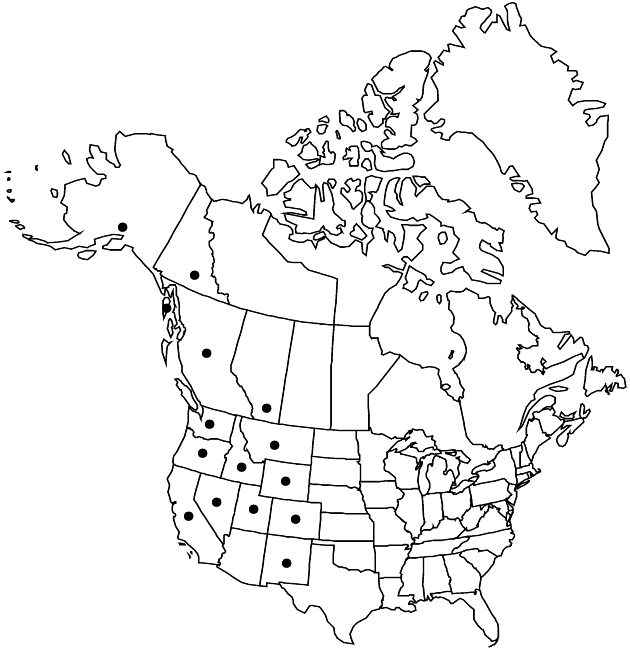Difference between revisions of "Erigeron glacialis"
Bot. Gaz. 37: 270. 1904.
FNA>Volume Importer |
imported>Volume Importer |
||
| Line 8: | Line 8: | ||
}} | }} | ||
|common_names=Subalpine fleabane | |common_names=Subalpine fleabane | ||
| + | |special_status={{Treatment/ID/Special_status | ||
| + | |code=F | ||
| + | |label=Illustrated | ||
| + | }}{{Treatment/ID/Special_status | ||
| + | |code=E | ||
| + | |label=Endemic | ||
| + | }} | ||
|basionyms={{Treatment/ID/Basionym | |basionyms={{Treatment/ID/Basionym | ||
|name=Aster glacialis | |name=Aster glacialis | ||
| Line 30: | Line 37: | ||
-->{{Treatment/Body | -->{{Treatment/Body | ||
| − | |distribution= | + | |distribution=Alta.;B.C.;Yukon;Alaska;Calif.;Colo.;Idaho;Mont.;N.Mex.;Nev.;Oreg.;Utah;Wash.;Wyo. |
|discussion=<p>Varieties 2 (2 in the flora).</p> | |discussion=<p>Varieties 2 (2 in the flora).</p> | ||
|tables= | |tables= | ||
| Line 60: | Line 67: | ||
|basionyms=Aster glacialis | |basionyms=Aster glacialis | ||
|family=Asteraceae | |family=Asteraceae | ||
| − | |distribution= | + | |distribution=Alta.;B.C.;Yukon;Alaska;Calif.;Colo.;Idaho;Mont.;N.Mex.;Nev.;Oreg.;Utah;Wash.;Wyo. |
|reference=None | |reference=None | ||
|publication title=Bot. Gaz. | |publication title=Bot. Gaz. | ||
|publication year=1904 | |publication year=1904 | ||
| − | |special status= | + | |special status=Illustrated;Endemic |
| − | |source xml=https:// | + | |source xml=https://bibilujan@bitbucket.org/aafc-mbb/fna-data-curation.git/src/bb6b7e3a7de7d3b7888a1ad48c7fd8f5c722d8d6/coarse_grained_fna_xml/V19-20-21/V20_745.xml |
|tribe=Asteraceae tribe Astereae | |tribe=Asteraceae tribe Astereae | ||
|genus=Erigeron | |genus=Erigeron | ||
Revision as of 20:51, 27 May 2020
Perennials, 5–55(–70) cm; rhizomatous, fibrous-rooted, caudices usually simple, thick. Stems erect to ascending, hirsute or hirsuto-villous to densely strigillose (hairs loosely appressed, slightly crinkled), eglandular. Leaves basal (usually persistent) and cauline; basal blades linear-oblanceolate to broadly lanceolate or spatulate, (20–)30–160(–200) × 7–45 mm, cauline gradually reduced distally (bases distinctly subclasping, except when greatly reduced), margins entire, faces glabrous or glabrate, hirsute, or villous to sparsely villosulous, eglandular. Heads 1(–8). Involucres 6–9(–12) × 10–22(–25) mm. Phyllaries in 2–3(–4) series (faces and margins) usually glabrous, rarely sparsely villous (cross walls not colored), densely and evenly stipitate-glandular. Ray florets 30–80; corollas usually blue to rose purple or pink, sometimes white to pale blue, 8–16(–25) mm (mostly 1.5–3 mm wide), laminae coiling. Disc corollas 3.8–6 mm. Cypselae 2.5–2.8 mm, (4–)5(–7)-nerved, faces sparsely strigose; pappi: outer of setae, inner of 20–30 bristles.
Distribution

Alta., B.C., Yukon, Alaska, Calif., Colo., Idaho, Mont., N.Mex., Nev., Oreg., Utah, Wash., Wyo.
Discussion
Varieties 2 (2 in the flora).
Selected References
None.
Key
| 1 | Peduncles densely strigillose with loosely appressed, slightly crinkled hairs; leaf faces glabrous or villous | Erigeron glacialis var. glacialis |
| 1 | Peduncles hirsute to hirsuto-villous; leaf faces hirsute to hirsuto-villous | Erigeron glacialis var. hirsutus |